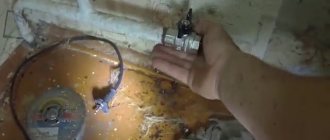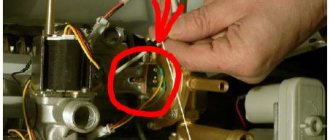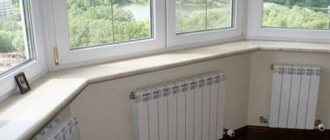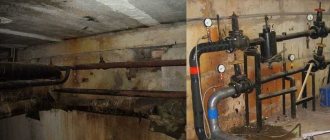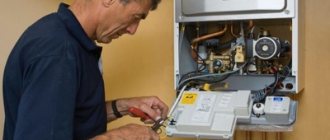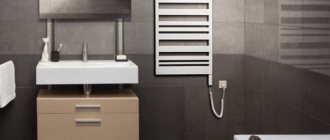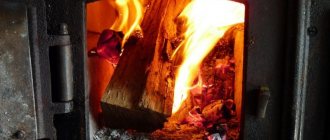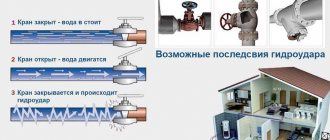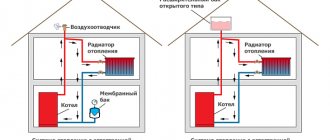There are frequent situations when the problem of a heating battery not heating arises. Sometimes you have to rack your brain in search of the reasons why the situation is happening and how to fix it. We have collected for you 7 possible reasons why radiators may not heat up and offer to study each in detail.
Important! This article is especially relevant when starting heating systems. Many, like you at the moment, may be experiencing difficulties with batteries. Your repost of our material may help someone quickly solve their problem. Don't forget to click on the social buttons. networks at the very bottom of the article!
Bypass
The bypass is the same pipe that stands in front of the installed heating device. Everyone has one, it’s needed to bypass water past the battery. If installed incorrectly - too far from the radiator, or in line with the central riser, it does not allow water, which tends to travel along the shortest path, to circulate normally, heating the radiator sections. In this situation, they will either not heat at all or will be very bad. Check how your bypass is installed. Perhaps this is the direct reason why the batteries do not heat up
Methods for flushing radiators and new methods for cleaning the internal surface ↑
During operation, the internal surface of the heating system becomes covered with rust, salt deposits, and other impurities. All this complicates the circulation of hot water and significantly reduces the air temperature in the apartment. Regular cleaning of heating radiators removes blockages and restores normal circulation of coolant.
It is possible to clean the heat exchanger, equipped with outlet and inlet taps, even during the period when the central heating is already working, but when the riser is hot, the batteries remain cold. First of all, turn off both taps, then remove the radiator using a suitable wrench and divide it into sections. The next part of the work does not require special skills - each element is washed well under a strong stream of water. If a lot of scale has accumulated inside and the sediment cannot be easily removed, you will have to deal with it using chemicals. After drying, the entire structure is assembled to its original form, and all joints are carefully sealed.
This deposit prevents the heating system from working properly.
Heavy batteries that cannot be removed are washed on site. To do this, remove one plug, and then pour inside, preferably under pressure, hot water to which a chemical solvent has been added, for example, soda ash. The heating element is left in this state for a couple of hours, then the solution is drained and clean water is poured under pressure. It is advisable to do several rinses, and if necessary, you can repeat the chemical treatment. To enhance the effect, you can lightly tap the compartments before pouring water, this will help the plaque move away from the walls.
Ideally, flushing should be done before the start of the heating season, when utility services have not yet poured water into the system, but have already managed to blow out the risers.
For heat exchangers that are difficult to turn off and wash, there is professional equipment that allows you to precisely remove deposits in any season, including the heating season. The result is achieved through high pressure, compressed air and shock waves. Such equipment allows you to clean not only radiators, but also pipes.
A powerful device can clean the system at any time of the year.
Three way valve
Such a tap is required to switch the bypass-battery direction. If this is the reason that the radiator does not heat, then the problem can be eliminated in 3 ways:
- No disassembly. In cases where the tap turns easily, but switching does not occur at all (neither one nor the other works), you can try to develop the device using multiple turning movements. In this case, blockages, as a rule, are washed away by the flow, going into the riser. The operation of shut-off valves is restored in full.
- With partial disassembly. There's no way to turn the tap? We're not trying to break it. Carefully unscrew the locking screw of the handle, remove it, place the screw back in order to prevent deformation of the part during further work. Further actions are carried out with a wrench. It is not recommended to use round nose pliers, pliers, etc. The reason is the same as with the screw - not to damage the rod. Holding the rod with a wrench, we smoothly rock it back and forth, starting with minimal vibrations. If you cannot make minimal movements, slightly loosen the large hex nut that presses the stuffing box seal. If it starts to dig in, place a small container. Continuing the work, moving the rod, press the seal into place, turning the large nut back accordingly. We unscrew the screw, install the handle, screw in the screw, and rejoice.
- In rare cases, when the internal stop is simply torn off, the crane has the ability to “spun in a circle” endlessly - we simply select the position of the handle in which normal operation is ensured.
How to eliminate air locks in radiators ↑
Air lock is the most common cause of cold radiators. The appearance of air is a natural process caused by heating the water, sudden filling of the system, and a violation of the tightness. Fixing this problem is not difficult if the system is equipped with bleed valves. On modern radiators they are located at the top of the product and operate without intervention, periodically bleeding air from the batteries. If automation is not provided, then the valve is opened manually and air is released until water appears.
Modern heating devices are equipped with special valves
Older type heating appliances do not have such taps. In this case, you will have to work a little and remove the plug. Before you start unscrewing, be sure to place the basin on the floor. Under no circumstances should the lid be completely unscrewed; it should only be unscrewed slightly until a barely audible hiss appears. At this point, you need to put the key aside and wait until all the excess air comes out of the system and water begins to ooze out. After this, the plug must be carefully tightened. Just in case, you can leave the basin for a while to make sure that water does not drip.
It is not allowed to completely unscrew the plug! This may cause the apartment to flood!
Human factor
A person can also become the direct cause of a non-heating radiator. And usually they are as follows:
- A riser that they simply forgot to turn on because “it was late and the plumbers were tired.”
- Closed valve of the automatic air vent system.
- Incorrect connection during installation.
- Child-closed three-way valve.
They can be solved by calling the appropriate support service, correctly connecting the battery (or bypass, see below), and carefully checking the taps.
Incorrect battery connection
Incorrect or ineffective connection of the radiator is also the reason for its poor heating. The best option is to supply water to the top hole of the battery and exit through the bottom. In this case, both connections must be on the same side.
Options for connecting the battery to the system
The cross method involves the return outlet on the other side of the radiator. This is also an efficient option that allows only 2% heat loss. There are other connection options, but they have more noticeable losses.
Incorrect radiator connection
An incorrect connection can completely deprive you of heat . This includes the case when the supply is installed in the lower hole, and the outlet in the upper. If such installation errors occur, they should be eliminated as soon as possible.
Flow extender
A typical problem for a two-pipe system. Is it possible to make any number of sections? It is possible, but the very last sections of the battery will not warm up. Cause? Water, like a person, looks for “where it’s easier” and follows the shortest path. In order to “teach order” to the lazy one - water, a flow extender is required. Factory-made, or made independently from a piece of pipe. By directing the fluid to the middle of the structure, it will force the flow to circulate correctly, reaching the farthest ends of the heat exchanger.
Interesting fact: the same problem can be solved by connecting the heating device “diagonally”. But this is rarely used, due to the lack of aesthetics of this solution on ready-made systems.
Why do the batteries in the apartment not warm up well?
Reason 1: air locks
Often the radiators in the apartment are cold or not warm enough due to air locks. As a rule, this problem is relevant for residents of upper floors, since the air tends upward through the pipes. In order to eliminate air jams, a Mayevsky crane is used. It allows you to release the collected air and ensure full circulation of the coolant in the pipes.
Reason 2: non-optimal connection of heating batteries
The first sign of an incorrect connection is uneven heating of the battery. The radiator will not heat up enough if the water supply comes from below. In this case, it is best to change the connection diagram from the side or bottom to diagonal.
Reason 3: a large number of radiator sections
Uneven and weak heating of the radiator may be the result of too many sections. It is better not to allow the battery to be installed in more than 12 sections.
Reason 4: low coolant temperature
Sometimes batteries remain cold in winter due to the low temperature of the coolant itself (water). In this case, you must contact the house management.
Balancing valve
Privately owned houses have the greatest variety of heating systems. Cases of two or three branch structures are not uncommon. In this case, as in the above cases, the tendency of the liquid to take the shortest route naturally remains. The longest arm may have no circulation at all or very weakly expressed. The heat transfer of such a link will be the same - small, absent. The battery will not heat or heat poorly.
To eliminate the situation, it will be necessary to install a balancing valve in order to equalize the pressure of different branches and uniform heating.
Clogged heating system
Rust, salt deposits and other contaminants can significantly reduce the diameter of the holes for the passage of coolant or completely close them. The problem causes the home owner to bleed the air, but the battery is still cold. The solution is cleaning with water under pressure or a special solution.
Deposits in the pipe
If shut-off valves are installed in front of the radiator, then the procedure can be completed even during the heating season . First, the coolant supply is shut off, then the connecting elements are unscrewed. In a private house, it is more convenient to take the battery outside and clean it there. In an apartment, they are usually placed in the bathroom, having previously protected the enamel of the bathtub from scratches and chips.
Pneumatic radiator flushing device
Water is supplied to the battery from a pneumatic device, and for best effect it must be hot. To remove rust and deposits, tap the radiator. In particularly advanced cases, a special mixture is poured in, which acts on the deposits for several hours, then is washed off.
Clogged radiator
Sometimes the reason that the radiator does not heat can be a simple blockage. When determining the causes of blockage, let’s highlight the symptoms:
- It only warms around the perimeter.
- Only the top part.
- The bottom is heated, the top is not.
- Only a few sections out of all possible provide heat (if the bypass location is correct)
Could it be just the old battery that is clogged? Not at all. New systems (modern and ultra-modern, aluminum and cast iron) suffer from this just as often. The problem may lie in the general contamination of the system:
- From long-term use.
- Due to installation errors.
- Sediments with high water hardness.
- Erosion of system elements (oxide, rust).
How to get rid of it?
Modern heating devices with properly installed shut-off valves include an “American” valve, by turning off which the non-working part can be easily dismantled and cleaned, purged, and washed under pressure.
It’s harder where the equipment is “countless years old.” To disassemble, you may have to turn to specialists, emptying (preliminarily or with their help) the entire volume (usually just water).
Cast iron radiators can be cleaned. It is recommended to replace steel flat flow welded radiators with new ones of other models. But it is they, ironically, that are most often susceptible to rusting and clogging of channels - due to the design features and materials used. Therefore, they often do not heat properly. An additional reason not to clean this type of heating device is the risk of leakage of the eroded wall due to its thinning in the process of peeling off oxidized metal flakes. A leak can be costly (even if you forget about the cost of repairing the “junk”). This is the same case when the stingy one has every chance to pay twice, or even three times.
Interesting fact: cast iron radiators clog 3-5 times less often than aluminum or stamped ones.
Briefly about the heat supply of an apartment building
If you have the courage to figure out on your own why the batteries do not heat well, it would be a good idea to familiarize yourself with the basic concepts associated with heating a residential apartment building.
Most high-rise buildings use a single-pipe system equipped with U-shaped risers. Let us show a conditional diagram of the heat supply of three floors.
Hot water (red in the diagram) rises through one riser and passes, for example, through the bedrooms, to the top floor, where, in a loop, it goes down through other rooms (blue). This scheme has been designed since Soviet times for the use of cast iron radiators. Hot water enters the lower radiator manifold and, after passing through all sections, leaves the battery through the upper manifold.
A special role was given to jumpers (bypasses). They maintained general forced circulation throughout the entire pipeline of the U-shaped riser (in the diagram - for the six radiators shown), acting as a safety net in cases of radiator clogging with liquid technical dirt that accumulates during many years of operation. When passing through the riser, some part of the total displacement of hot water supplied from below turned to the radiator on one floor, and the rest passed by unhindered, delivering heat to the apartments adjacent to the riser.
The aluminum heating radiators that have appeared are designed for two-pipe systems with hot water supplied through the upper collector and its output from the lower collector. They have a completely different design of the internal cavity, and accordingly, different hydraulics. When they began to indiscriminately replace obsolete cast iron radiators with modern aluminum ones, but maintaining a single-pipe design, the heat flow from hot water inside the radiators began to weaken due to the divergent directions of convection heat flows from the cooling water and the hot water pumped by an external pump.
Concerned that the heating radiator was not heating up, residents began to resort to various technical tricks, not caring at all about their freezing law-abiding neighbors. This inconsistency between the types of structures and the decrease in the speed of water passing through the radiator led to dirt deposits in the sections. Every year more and more sludge is deposited, and now the last battery, completely clogged with sludge, no longer heats. This epidemic then covers the entire radiator.
